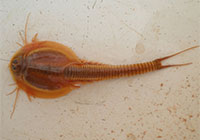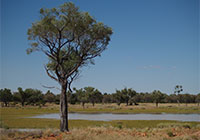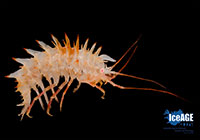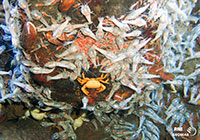Research Projects
IceAGE Amphipoda
 The international IceAGE Programme (Icelandic marine Animals: Genetics and Ecology) studies marine areas in the northern Atlantic. This region is particularly sensitive to climate change. The area has a wide temperature range (from -0.9°C to 14°C). Underwater mountain ranges covered with cold-water corals run from below 3000 m to 300 m water depth ... [ more ]
The international IceAGE Programme (Icelandic marine Animals: Genetics and Ecology) studies marine areas in the northern Atlantic. This region is particularly sensitive to climate change. The area has a wide temperature range (from -0.9°C to 14°C). Underwater mountain ranges covered with cold-water corals run from below 3000 m to 300 m water depth ... [ more ]
Phylogeny and genome evolution of the Crustacea by means of phylogenomic studies
 Insects are land-dwelling crustaceans. This finding has turned our understanding of the evolution of crustaceans upside down. But despite intensive research, the relationships between and even within the large crustacean taxa have not yet been convincingly elucidated ... [ more ]
Insects are land-dwelling crustaceans. This finding has turned our understanding of the evolution of crustaceans upside down. But despite intensive research, the relationships between and even within the large crustacean taxa have not yet been convincingly elucidated ... [ more ]
Evolutionary systematics of Branchiopoda, especially Australian Notostraca and Spinicaudata
 Australia harbours the world's greatest diversity of "large crayfish". As many of the species are difficult to distinguish morphologically, this diversity was not recognised for a long time and thus the diversity of these crustaceans was greatly underestimated ...
Australia harbours the world's greatest diversity of "large crayfish". As many of the species are difficult to distinguish morphologically, this diversity was not recognised for a long time and thus the diversity of these crustaceans was greatly underestimated ...
[ more ]
Influence of permanent eggs on the population genetics of branchiopoder crustaceans
 Branchiopod crustaceans reproduce with the help of special drought-resistant permanent eggs. These permanent eggs can survive for years and even decades in the sediment of dried-up temporary water bodies. When the waters fill up with water again, the permanent eggs hatch and thus form a new generation and local population ... [ more ]
Branchiopod crustaceans reproduce with the help of special drought-resistant permanent eggs. These permanent eggs can survive for years and even decades in the sediment of dried-up temporary water bodies. When the waters fill up with water again, the permanent eggs hatch and thus form a new generation and local population ... [ more ]
Systematics, evolution, ecology, biogeography of Peracarida (Crustacea, Malacostraca) and Polychaeta of the deep sea
 The deep sea appears to us as a uniform, coherent habitat. But is this habitat also so uniform for the organisms living there? To what extent do mountains, deep-sea trenches or other structures represent obstacles?
The deep sea appears to us as a uniform, coherent habitat. But is this habitat also so uniform for the organisms living there? To what extent do mountains, deep-sea trenches or other structures represent obstacles?
[ more ]
Megafauna in deep-sea hydrothermal systems
 The aim of the biodiversity project is to characterise benthic communities in the area north of the Rodriguez-Triple Junction (south central Indian Ridge) and along the southeast Indian Ridge. Species composition, distribution patterns and dependence on environmental variables will be investigated ... [ more ]
The aim of the biodiversity project is to characterise benthic communities in the area north of the Rodriguez-Triple Junction (south central Indian Ridge) and along the southeast Indian Ridge. Species composition, distribution patterns and dependence on environmental variables will be investigated ... [ more ]

